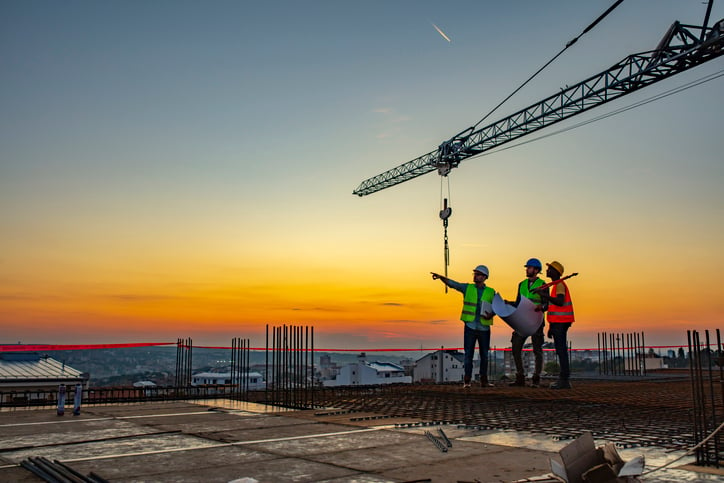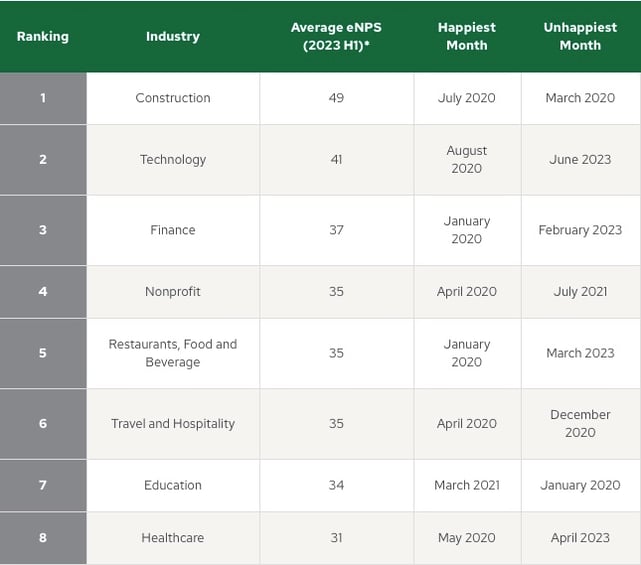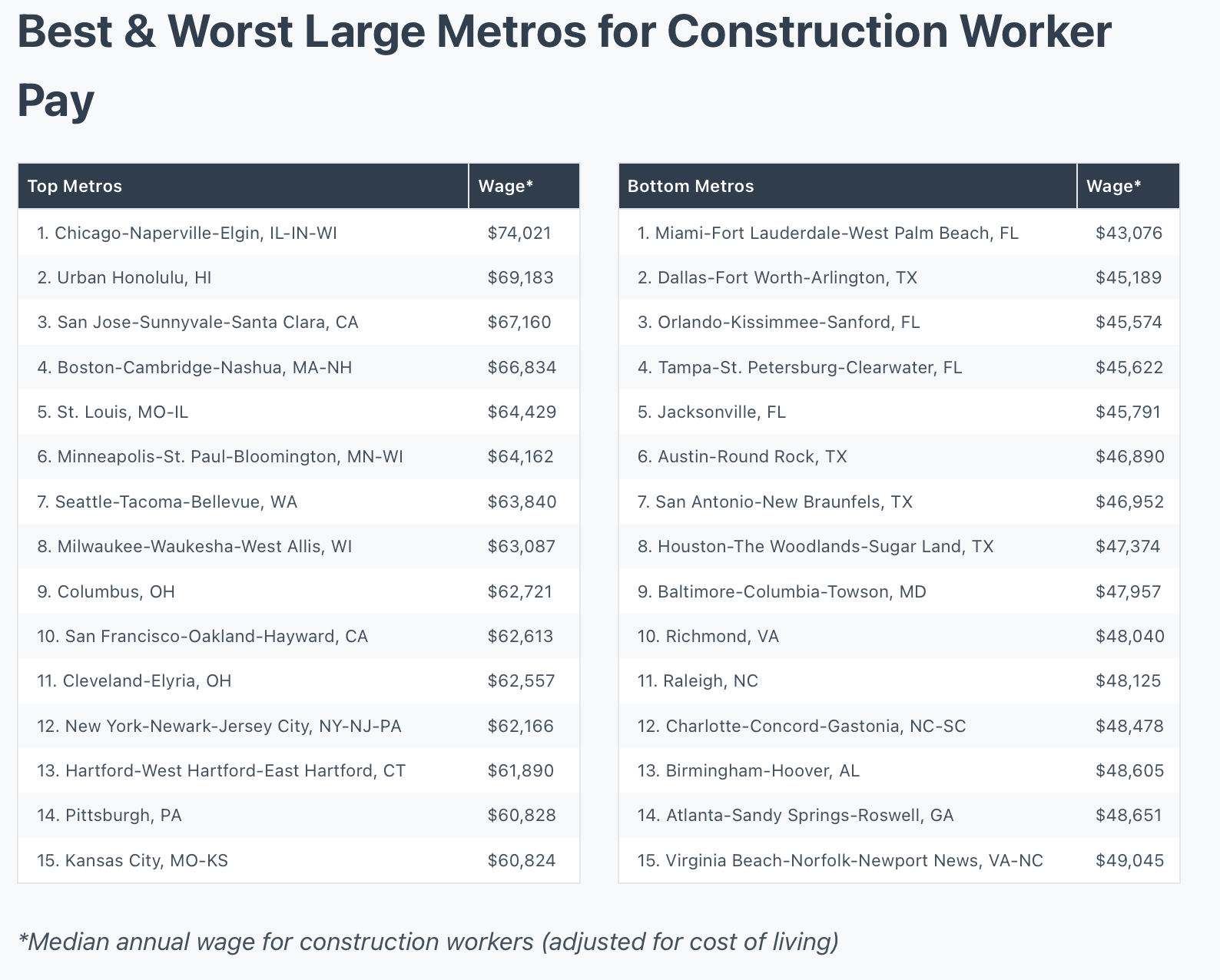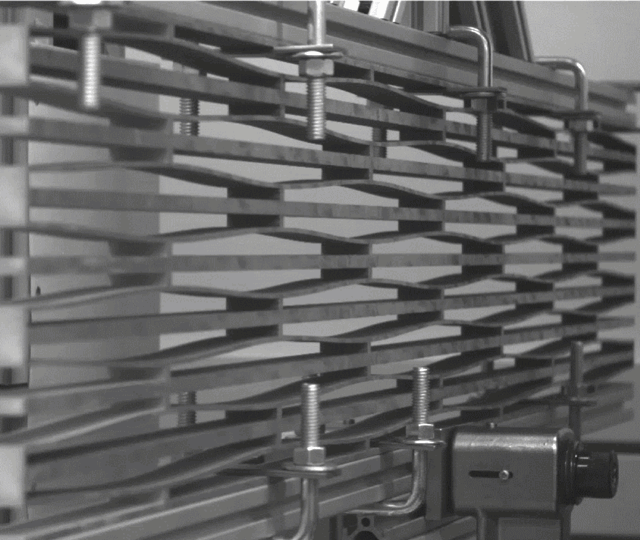
It may be the spooky season but the outlook remains sunny for the construction industry as we leave summer behind and round the bend into October.
Expect higher than average happiness, best-in-class salaries in the Midwest, a bump in construction starts, and growing wage and job numbers nationwide—plus a peak at a new type of futuristic material that could revolutionize how we build earthquake and impact-resistant structures.
Jump Ahead:
Construction Workers Happiest of Any Industry
Construction workers have the highest levels of self-reported happiness, according to a new report from Bamboo HR.

Image Source: Bamboo HR
The data comes from Bamboo’s analysis of more than 1.4 billion self-reported employee Net Promoter Scores® —a numeric rating of an employee’s likelihood to recommend their employer as a good place to work—collected from more than 1,600 companies since Jan. 2020. Bamboo’s analysis also gauged fluctuations in eNPS scores as a function of volatility and average volatility over time.
“The construction industry is the happiest on our list,” the Bamboo report reads, “potentially because of rising wages and plentiful job opportunities. However, experts predict labor shortfalls that may put pressure on employees in the months ahead. Human resources professionals should focus on refining their recruitment strategies and training programs to prepare for an influx of less experienced workers.
The relative good cheer of construction workers comes amid a “steep and steady drop” in employee happiness across other industries. Worker happiness overall has declined at a rate of about 6% since 2020, according to Bamboo HR. The drop-off has been particularly sharp in 2023, which has seen a 9% decrease in happiness levels since January, a rate of decline 10 times facter than the previous three years.
Bamboo attributes the marked decline in overall worker happiness in large part to the lingering physical, mental, and economic health impacts of 2020 COVID-19 pandemic.
Illinois Leads Pack in Construction Worker Pay
If you’re a construction worker in the United States looking for higher pay, you may want to consider moving to the Midwest.
Illinois leads the nation among a list of other Midwestern states that have the highest wages for construction workers compared to other regions of the US, according to a recent report by Construction Coverage. After adjusting for cost of living, the top five states for construction workers in terms of median annual salary are as follows:
- Illinois: $73,630
- Minnesota: $63,390
- North Dakota: $62,336
- Wisconsin: $61,877
- Ohio: $61,141
If you prefer city life, Illinois wins again, with Chicago capping a list of cities across the US that pay construction workers the highest wages. Not all the cities on the list are in the Midwest, but the Midwest remains disproportionately represented compared to other regions. Here’s the top five large metro areas with the highest median annual salary for construction workers:
- Chicago, IL: $74,021
- Urban Honolulu, HI: $69,183
- San Jose-Sunnyvale-Santa Clara, CA: $67,160
- Boston-Cambridge-Nashua, MA-NH: $66,834
- Louis, MO-IL: $64,429

Image Source: Construction Coverage
By contrast, the Southern US pays construction workers the least compared to other regions. Indeed, the 10 states where construction workers are paid the least are all in the South. The five worst states for construction workers in terms of median annual salary are as follows:
- Arkansas: $44,217
- Florida: $44,602
- Alabama: $45,961
- Mississippi: $46,189
- Texas: $46,710
Nationwide, full and part-time construction workers in the US earn 9% more per year ($50,570) compared to the median wages ($46,310) of all other occupations.
Construction Starts on the Rise
New construction appears to be on the upswing as October kicks off the final quarter of 2023. However, total year-to-date construction starts through August are 5% lower than they were during the same timeframe in 2022.
Here are the numbers from the latest report by Dodge Construction Network:
- Total construction starts rose 6% in August 2023 to a seasonally adjusted rate of $1.3 trillion.
- Non-residential starts rose 40% .
- Residential and nonbuilding starts declined by 1% and 14% respectively.
The month-to-moth gains in non-residential construction from July to August are largely due to a 285% surge in new manufacturing projects, according to Dodge. Still, total non-residential construction starts in August on a year-to-date basis were 9% lower than 2022.
“Despite the August gain, the construction sector is running uphill,” said Richard Branch, chief economist for Dodge Construction Network. “Fear of an imminent recession seems to have abated, which should provide a boost of confidence to the sector. However, higher interest rates, labor shortages and significantly tighter lending standards will weigh down starts in the final quarter of the year. This will persist for the foreseeable future, lasting until interest rates start to move lower.”
Construction Wages and Job Numbers Growing
The construction sector added 16,000 jobs and saw a 6% year-to-year rise in annual wages in September, according to a recent national employment report by ADP Research Institute in collaboration with the Stanford Digital Economy Lab.
Construction is faring well compared to many other industries, some of which shed jobs within the same timeframe.
“We are seeing a steepening decline in jobs this month,” said Nela Richardson, chief economist ADP, said of the overall report. “Additionally, we are seeing a steady decline in wages in the past 12 months.
The sectors that saw the largest losses were professional/business services (-32,000), trade/transportation/utilities (-13,000), and manufacturing (-12,000).
Construction saw the fourth highest pay increase behind the financial activities (6.2%), education/health services (6.4%), and leisure/hospitality (6.7%) sectors.
Intelligent Building Materials Unveiled

Image Source: Purdue University
Construction workers may someday work with super-elastic “intelligent” building materials that dissipate damage and avoid deformation, making them ideal for earthquake and impact-resistant structures.
Civil engineering researchers at Purdue University say that this new class of materials can dampen the effects of bending, compression, torque, and tensile stress.
Pablo Zavattieri, a professor in civil engineering at Purdue, leads the research team that developed the materials, which are capable of switching back and forth between stable configurations.
“We have produced intelligent architected materials as large as 12 inches, which are ideal for applications like building and bridge construction to absorb and harness energy,” Zavattieri said in a recent press-release. “Conversely, we have created materials with unit cells smaller than the thickness of a human hair. This scalability opens up a world of possibilities from macro to micro applications.”
According to a 2019 paper on the subject published in Nature, the final form of these intelligent building materials looks similar to the geometric lattice pattern of a honeycomb. Zavattieri says it is possible to fabricate these intelligent materials—or Phase Transforming Cellular Materials (PXCMs)—out of virtually any material with sufficient elastic properties, including polymers, metal, rubber, and even concrete.
“These materials are designed for fully recoverable, energy-dissipating structures, akin to what is referred to as architected shape memory materials, or phase transforming cellular materials, known as PXCM,” Zavattieri said. “They can also exhibit intelligent responses to external forces, changes in temperature, and other external stimuli."